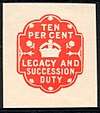Taxation in Australia
Income taxes are the most significant form of taxation in Australia, and collected by the federal government through the Australian Taxation Office. Australian GST revenue is collected by the Federal government, and then paid to the states under a distribution formula determined by the Commonwealth Grants Commission.
.png)
Australia maintains a relatively low tax burden in comparison with other wealthy, developed nations, at 27.8% of GDP in 2018.[1]
History
When the first Governor, Governor Phillip, arrived in New South Wales in 1788, he had a Royal Instruction that gave him power to impose taxation if the colony needed it. The first taxes in Australia were raised to help pay for the completion of Sydney's first gaol and provide for the orphans of the colony. Import duties were put on spirits, wine and beer and later on luxury goods.
After 1824 the Government of New South Wales raised extra revenue from customs and excise duties. These were the most important sources of revenue for the colony throughout the 19th century. Taxes were raised on spirits, beer, tobacco, cigars and cigarettes. These taxes would vary between each of the Australian colonies, and this state of affairs remained in place after the colonies achieved statehood.
Thomas de la Condamine[2] was appointed as the first Collector of the Internal Revenue on 7 April 1827 with the actual office of the Collector of the Internal Revenue established on 1 May 1827 by Governor Ralph Darling. When de la Condamine's appointment was not confirmed by the Secretary of State for War and the Colonies William Huskisson, the duties fell to James Busby who held the position until December 1835 when the position was filled by William McPhereson.[3] The Collector of the Internal Revenue collected all revenue, such as moneys received from the sale or rental of land except that from customs duties and court fees. The Internal Revenue Office was abolished on 4 January 1837 with its business becoming the responsibility of the Colonial Treasurer.[4]
Colonial governments also raised money from fees on wills and stamp duty, which is a tax imposed on certain kinds of documents. In 1880, the Colony of Tasmania imposed a tax on earnings received from the profits of public companies.
Income taxes were introduced in the late 19th century in a few of the colonies before Federation. In 1884, a general tax on income was introduced in South Australia, and in 1895 income tax was introduced in New South Wales at the rate of six pence in the pound, or 2.5%.[5] Federal income tax was first introduced in 1915, in order to help fund Australia's war effort in the First World War.[6] Between 1915 and 1942, income taxes were levied at both the state and federal level.[6]
The Taxation Administration Act 1953 was assented to on 4 March 1953.[7]
In 1972, the government of William McMahon appointed the NSW Supreme Court judge Kenneth Asprey to conduct a full and wide-ranging review of the tax system. Although controversial when completed for the Whitlam Government in 1975, the Asprey report on taxation has acted "as a guide and inspiration to governments and their advisers for the following 25 years." The main recommendations of the report have all been implemented and are today part of Commonwealth taxation in Australia.[8]
On 20 September 1985, Capital gains tax was introduced. The GST replaced the older wholesale sales tax in 2000. In July 2001, the Financial Institutions Duty was abolished. Between 2002 and 2005, Bank Account Debits Tax was abolished.
On 1 July 2012 the Federal government introduced a Carbon price, requiring large emitters of carbon dioxide to purchase permits, the government also introduced a Minerals Resource Rent Tax, originally called a resources 'super profits' tax in the Henry Tax Report.[9] The revenue from the carbon pricing regime was used to reduce income tax by increasing the tax-free threshold and increase pensions and welfare payments, as well as introducing compensation for some affected industries. The Carbon Tax and associated Resources Rent tax were repealed in 2014.[10][11]
The Government has brought back a duty on financial institutions in the form of a 'major bank levy' on the five largest banks in Australia.[12]
Forms of taxes and excises, both Federal and State
Personal income taxes
Income taxes on individuals are imposed at the federal level. This is the most significant source of revenue in Australia. State governments have not imposed income taxes since World War II.
Personal income taxes in Australia are imposed on the personal income of each person on a progressive basis, with higher rates applying to higher income levels. Unlike some other countries, personal income tax in Australia is imposed on an individual and not on a family unit.
Individuals are also taxed on their share of any partnership or trust profits to which they are entitled for the financial year.
Capital gains tax
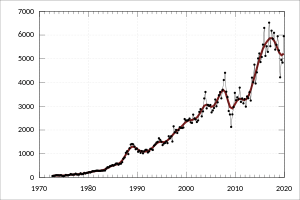
Capital Gains Tax (CGT) in the context of the Australian taxation system applies to the capital gain made on disposal of any asset, except for specific exemptions. The most significant exemption is the family home. Rollover provisions apply to some disposals, one of the most significant is transfers to beneficiaries on death, so that the CGT is not a quasi death duty.
CGT operates by having net gains treated as taxable income in the tax year an asset is sold or otherwise disposed of. If an asset is held for at least 1 year then any gain is first discounted by 50% for individual taxpayers, or by 331⁄3% for superannuation funds. Net capital losses in a tax year may be carried forward and offset against future capital gains. However, capital losses cannot be offset against income.
Personal use assets and collectables are treated as separate categories and losses on those are quarantined so they can only be applied against gains in the same category, not other gains. This works to stop taxpayers subsidising hobbies from their investment earnings.
Corporate taxes
A company tax is paid by companies and corporations on profits and/or assets. Unlike personal income taxes which use a progressive scale, company tax is calculated at a flat rate of 30% (25% for small businesses, which are defined as companies with revenue of less than $2 million per year). Tax is paid on corporate income at the corporate level before it is distributed to shareholders as dividends.
A tax credit (called a franking credit) is available to resident shareholders who receive the dividends to reflect the tax already paid at the corporate level (a process known as dividend imputation). A withholding tax applies on unfranked dividends paid to non-resident shareholders.[13]
From 2015/16, designated "small business entities" with an aggregated annual turnover threshold of less than $2 million were eligible for a lower tax rate of 28.5%. Since 1 July 2016, small business entities with aggregated annual turnover of less than $10 million have had a reduced company tax rate of 27.5%. Additionally, the Australian Government announced that from 2017/18, corporate entities eligible for the lower tax rate will be known as "base rate entities". The small business definition will remain at $10 million from 2017/18 onwards, however the base rate entity threshold (the aggregated annual turnover threshold under which entities will be eligible to pay a lower tax rate) will continue to rise until the base rate entities have an annual turnover of $50 million giving a tax rate of 25% to the entities below this threshold.[14]
| Company tax rate | Period | Notes |
|---|---|---|
| 45% | 1973–1979 | |
| 46% | 1979–1986 | |
| 49% | 1986–1988 | The system of company taxation replaced by dividend imputation in 1987 |
| 39% | 1988–1993 | |
| 33% | 1993–1995 | |
| 36% | 1995–2000 | Accelerated depreciation removed in 1999 |
| 34% | 2000–2001 | Refundable imputation credits introduced in 2000 |
| 30% | 2001–2017 | |
| 27.5% (small business)
30% |
2017– | Businesses with less than A$25 million annual turnover and where 80% or less of their revenue is passive income are taxed at the lower rate[15] |
Trustee liability taxes
Where all or part of the net trust income is distributed to either non-residents or minors, the trustee of that trust is assessed on that share on behalf of the beneficiary. In this case, the beneficiaries must declare that share of net trust income on their individual income tax returns, and also claim a credit for the amount of tax the trustee paid on their behalf.
Where the trust accumulates net trust income, the trustee is assessed on that accumulated income at the highest individual marginal rate.
In both cases the trustee will be issued a notice of assessment subsequent to lodging the trust tax return.
Goods and Services taxes
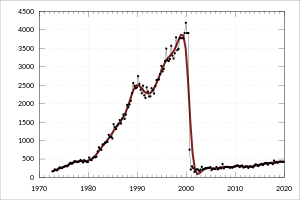

A goods and services tax (GST) is a value added tax levied by the federal government at 10% on the supply of most goods and services by entities registered for the tax. The GST was introduced in Australia on 1 July 2000 by the then Howard Liberal government. A number of supplies are GST-free (e.g., many basic foodstuffs, medical and educational services, exports), input-taxed (residential accommodation, financial services, etc.), exempt (Government charges) or outside the scope of GST.
The revenue from this tax is distributed to the States.
State governments do not levy any sales taxes though they do impose stamp duties on a range of transactions.
In summary, the GST rate of 10% is charged on most goods and services consumed in Australia. A business which is registered for GST would include the GST in the sale prices it charges. However, a business can claim a credit for the GST paid on business expenses and other inputs (called a GST credit). The business would pay to the Tax Office the difference between GST charged on sales and GST credits.
Two types of sales are treated differently:
- Suppliers of GST-free goods and services will not have to pay GST when they make a sale but they will be entitled to GST credits.
- Suppliers of input taxed goods and services do not have to charge GST on sales but they will not be entitled to claim GST credits from their purchases of inputs.
Property taxes
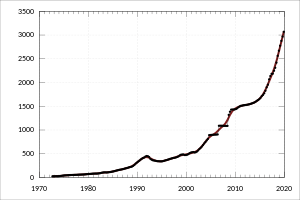
Local governments are typically funded largely by taxes on land value (council rates) on residential, industrial and commercial properties. In addition, some State governments levy tax on land values for investors and primary residences of high value. The State governments also levy stamp duties on transfers of land and other similar transactions.
Fire Service Levies are also commonly applied to domestic house insurance and business insurance contracts. These levies are required under State Government law to assist in funding the fire services in each State.
Departure tax
The Passenger Movement Charge (PMC) is an excise tax levied by the Australian government on all passengers departing on international flights or maritime transport.[16] The PMC replaced the departure tax in 1995 and was initially described as a charge to partially offset the cost to government of the provision of passenger facilitation at airports, principally customs, immigration and quarantine functions. It is classified by the International Air Transport Association as a departure tax, rather than an airport charge, as its revenue does not directly contribute to passenger processing at airports or sea ports.
Excise taxes
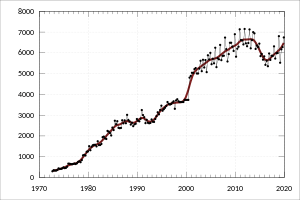
The Federal Government imposes excise taxes on goods such as cigarettes, petrol, and alcohol. The rates imposed may change in February and August each year in response to changes in the consumer price index.[17]
Fuel taxes in Australia
The excise tax on commonly used fuels in Australia as of October 2018[18] are as follows:
- A$0.416 per litre on Unleaded Petrol fuel (Includes standard, blended (E10) and premium grades)
- A$0.416 per litre on Diesel fuel (Ultra-low sulphur/Conventional)
- A$0.134 per litre on Liquified petroleum gas used as fuel (Autogas or LPG as it is commonly known in Australia)
- A$0.081 per litre on Ethanol fuel (Can be reduced/removed via Grants)
- A$0.041 per litre on Biodiesel (Can be reduced/removed via Grants)
Note: Petrol used for aviation is taxed at $0.03556 per litre
Luxury Car Tax
Luxury Car Tax is payable by businesses which sell or import luxury cars, where the value of the car is above $66,331, or $75,526 for fuel-efficient cars with a fuel consumption of less than 7L per 100 km.[19]
Customs duties
Customs duties are imposed on many imported goods, such as alcohol, tobacco products, perfume, and other items. Some of these goods can be purchased duty-free at duty-free shops.
Payroll taxes

Payroll taxes in Australia are levied by state governments on employers based on wages paid by them. Payroll taxes in Australia are different in each state. Typically the tax applies to all wages above a threshold. Groups of companies may be taxed as a single entity where their operations are significantly integrated or related.
Current Payroll Tax Rates and Thresholds[20]
| State | Annual Threshold | Tax Rate |
|---|---|---|
| New South Wales[21] | $750,000 | 5.45% |
| Queensland[22] | $1,100,000 | 4.75% |
| South Australia | $600,000 | 4.95% |
| Australian Capital Territory | $1,750,000 | 6.85% |
| Victoria[23] | $575,000 | 4.85% (metro), 2.425% (regional) |
| Western Australia[24] | $750,000 | 5.50% |
| Tasmania[25] | $1,010,023 | 6.10% |
| Northern Territory[26] | $1,500,000 | 5.50% |
Queensland and the Northern Territory payroll tax rates are effective rates on payrolls above $5.5 million and $5.75 million respectively. All other jurisdictions levy marginal rates. Some companies are eligible for deductions, concessions and exemptions.
Payroll taxes in Australian Capital Territory
From 1 July 2014:[27]
- The rate of payroll tax is 6.85%.
- The annual threshold is $1,850,000.
- The monthly threshold is $154,166.66.
Payroll taxes in New South Wales
From 1 July 2013:[27]
- The rate of payroll tax is 5.45%.
- Medicare payments are up to 12%
- Pension Fund contribution is 9.5%[28]
- The annual threshold is $750,000.
- The monthly threshold is:
- 28 days = $57,534
- 30 days = $61,644
- 31 days = $63,699
Employers, or a group of related businesses, whose total Australian wages exceed the current NSW monthly threshold, are required to pay NSW payroll tax.
Each monthly payment or 'nil' remittance is due seven days after the end of each month or the next business day if the seventh day is a weekend (i.e. August payment is due by 7 September). The annual reconciliation and payment or 'nil' remittance is due by 21 July.
Effective July 2007 – In NSW, payroll tax is levied under the Payroll Tax Act 2007 and administered by the Taxation Administration Act 1996.
Prior to 1 July 2007 – In NSW, payroll tax was levied under the Payroll Tax Act 1971 and administered by the Taxation Administration Act 1996.
Payroll taxes in Northern Territory
From 1 July 2012:[27]
- The rate of payroll tax is 5.50%.
- The annual threshold is $1,500,000.
- The monthly threshold is $125,000.
Payroll taxes in Queensland
Companies or groups of companies that pay $1,100,000 or more a year in Australian wages must pay payroll tax.[29] There are deductions, concessions and exemptions available to those that are eligible.
From 1 July 2012:[27]
- The rate of payroll tax is 4.75%.
- The annual threshold is $1,100,000.
- The monthly threshold is $91,666.
Payroll taxes in South Australia
A Payroll Tax liability arises in South Australia when an employer (or a Group of employers) has a wages bill in excess of $600,000 for services rendered by employees anywhere in Australia if any of those services are rendered or performed in South Australia.[30]
From 1 July 2012:[27]
- The rate of payroll tax is 4.95%.
- The annual threshold is $600,000.
- The monthly threshold is $50,000.
Payroll taxes in Tasmania
From 1 July 2013:[27]
- The rate of payroll tax is 6.1%.
- The annual threshold is $1,250,000.
- The monthly threshold is:
- 28 days = $95,890
- 30 days = $102,740
- 31 days = $106,164
Payroll taxes in Victoria
From 1 July 2014:[27]
- The rate of payroll tax is 4.85% (2.425% for regional employers)
- Medicare payments are up to 12%
- Pension Fund contribution is 9.5%[28]
- The annual threshold is $550,000.
- The monthly threshold is $45,833.
Payroll taxes in Western Australia
Payroll Tax is a general purpose tax assessed on the wages paid by an employer in Western Australia. The tax is self-assessed in that the employer calculates the liability and then pays the appropriate amount to the Office of State Revenue, by way of a monthly, quarterly or annual return.
From 1 July 2014:[27]
- The rate of payroll tax is 5.5%.
- The annual threshold is $800,000.
- The monthly threshold is $66,667.
On 8 December 2004 new legislation was passed making it mandatory for an employer that has, or is a member of a group that has, an expected payroll tax liability equal to or greater than $100,000 per annum, to lodge and pay their payroll tax return via Revenue Online (ROL). This amendment to the Payroll Tax Assessment Act 2002 is effective 1 July 2006.
Fringe Benefits Tax
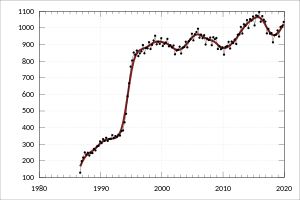
Fringe Benefits Tax is the tax applied by the Australian Taxation Office to most, although not all, fringe benefits, which are generally non-cash benefits. Most fringe benefits are also reported on employee payment summaries for inclusion on personal income tax returns that must be lodged annually.
Inheritance tax
There is no inheritance tax in Australia, with all states in Australia abolishing what was known as death duties in 1979[31] following the lead of the Queensland Government led by Joh Bjelke-Petersen.
Superannuation taxes
Private pensions (known as superannuation in Australia) may be taxed at up to three points, depending on the circumstances: at the point of contribution to a fund, on investment income and at the time benefits are received. In some circumstances, no tax is applicable at all.
The compulsory nature of Australian Superannuation means that it is sometimes regarded as being similar to social security taxes levied in other nations. This is more frequently the case when comparisons are being made between the tax burden of respective nations.
See also
| Library resources about Taxation in Australia |
- Australia Tax
- Bottom of the harbour tax avoidance
- Cherry-picking tax avoidance
- Negative gearing (Australia)
- Office of State Revenue (New South Wales)
- Salary packaging
- Tax file number
- Tax return (Australia)
- Tax Institute (Australia)
- Darwin Rebellion
Tax law:
Related:
References
- "Australia Economy".
- http://adb.anu.edu.au/biography/de-la-condamine-thomas-1974
- http://search.records.nsw.gov.au/series/14091
- http://search.records.nsw.gov.au/agencies/1183
- "Australian Tax History". Australian Tax Office. Archived from the original on 6 December 2009. Retrieved 3 August 2009.
- A brief history of Australia’s tax system Department of the Treasury
- https://www.comlaw.gov.au/Series/C1953A00001
- Gittins, Ross (15 June 2009). "A 'light on the hill' for our future tax reformers". The Age.
- c=AU, ou= Treasury ; o= Commonwealth of Australia. "Australia's Future Tax System – Home". Retrieved 29 March 2018.
- "Hockey hails 'damn good deal' on mining tax repeal". ABC News. 2 September 2014. Retrieved 29 March 2018.
- "Abbott hails carbon tax repeal after Senate vote". ABC News. 17 July 2014. Retrieved 29 March 2018.
- 7111, corporateName=Commonwealth Parliament; address=Parliament House, Canberra, ACT, 2600; contact=+61 2 6277. "The Major Bank Levy explained". www.aph.gov.au. Retrieved 29 March 2018.CS1 maint: numeric names: authors list (link)
- Office, Australian Taxation. "Business". www.ato.gov.au. Retrieved 29 March 2018.
- "Reducing the corporate tax rate". Australian Taxation Office. 4 July 2017.
- "Changes to company tax rates". Australian Taxation Office. 5 June 2019. Retrieved 7 July 2020.
- "Passenger movement charge (PMC)". Australian Customs and Border Protection Service. Retrieved 7 June 2013.
- "Excise". Australian Taxation Office. 6 August 2012. Retrieved 15 September 2012.
- "Excise rates for fuel".
- "Luxury car tax rate and thresholdes". Australian Tax Office policies. ATO. Retrieved 10 September 2018.
- "2012–13 Overview of State Taxes". Western Australia Department of Treasury. Archived from the original on 7 June 2013. Retrieved 21 May 2013.
- "Rates and thresholds". Payroll tax. NSW Government Office of State Revenue. Archived from the original on 16 May 2009. Retrieved 23 July 2009.
- "Payroll Tax in Queensland". Payroll Tax. QLD Government Office of State Revenue. Retrieved 31 August 2012.
- "Payroll Tax". State Revenue Office. Retrieved 3 May 2016.
- "General Information fact sheet" (PDF). Pay-roll Tax Forms and Brochures. Government of Western Australia Department of Treasury and Finance. Archived from the original (PDF) on 19 June 2015. Retrieved 15 May 2015.
- "Rates and thresholds". Retrieved 23 April 2011.
- "Payroll Tax Rates and Thresholds". payrolltax.gov.au. Australian Revenue Offices for the States and Territories of Australia. Retrieved 3 July 2015.
- "Australia – Victoria – CountryPedia – Papaya Global". CountryPedia – Papaya Global. Retrieved 28 December 2016.
- Office of State Revenue. "Payroll tax liability". Queensland Treasury and Trade. Retrieved 15 September 2012.
- "Revenue SA". Payroll Tax. Archived from the original on 9 August 2011.
- Disturbing Questions About the Estate Tax and the Timing of Deaths Archived 28 August 2009 at the Wayback Machine. Tax Foundation. Retrieved on 16 September 2012.
